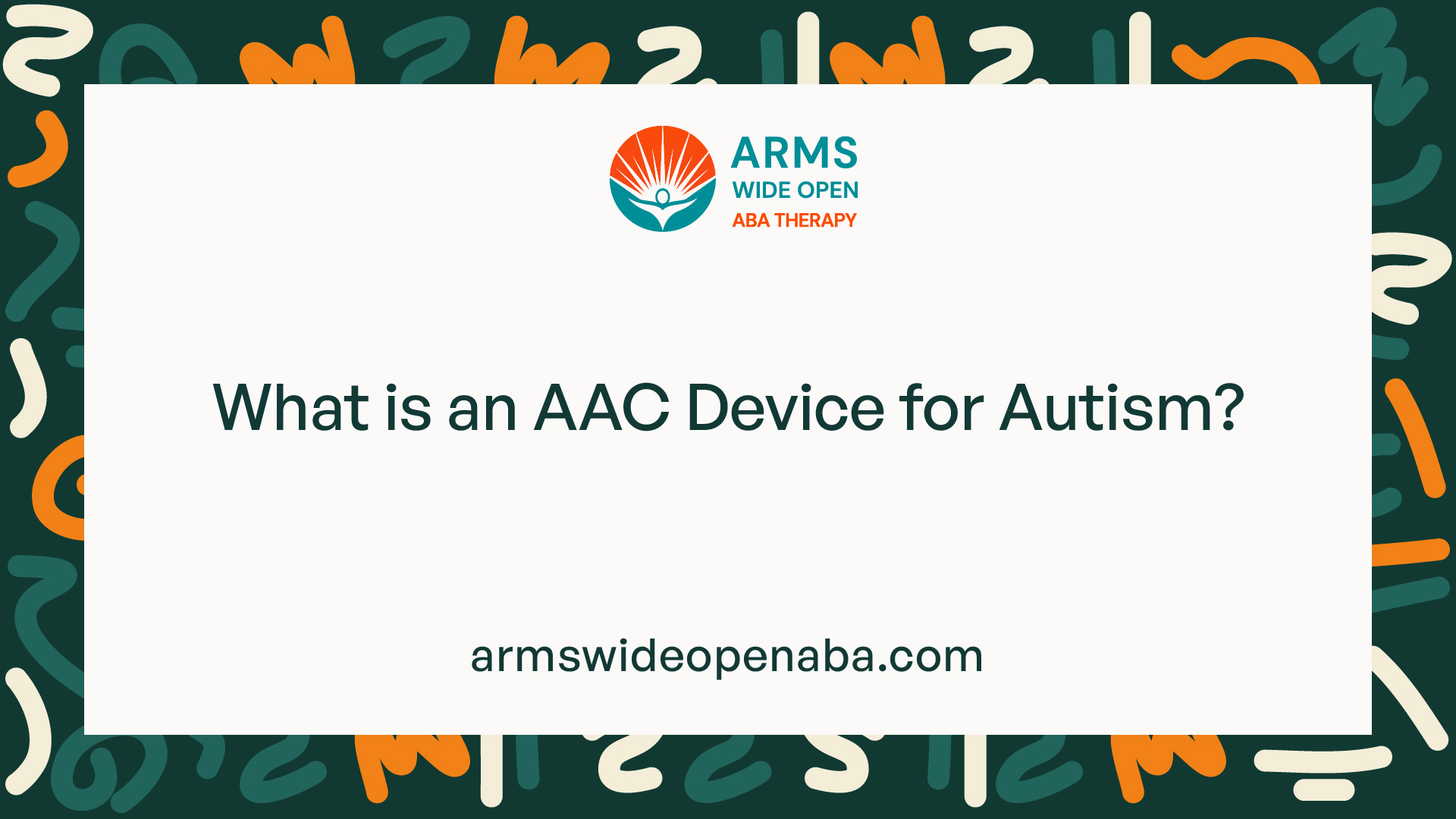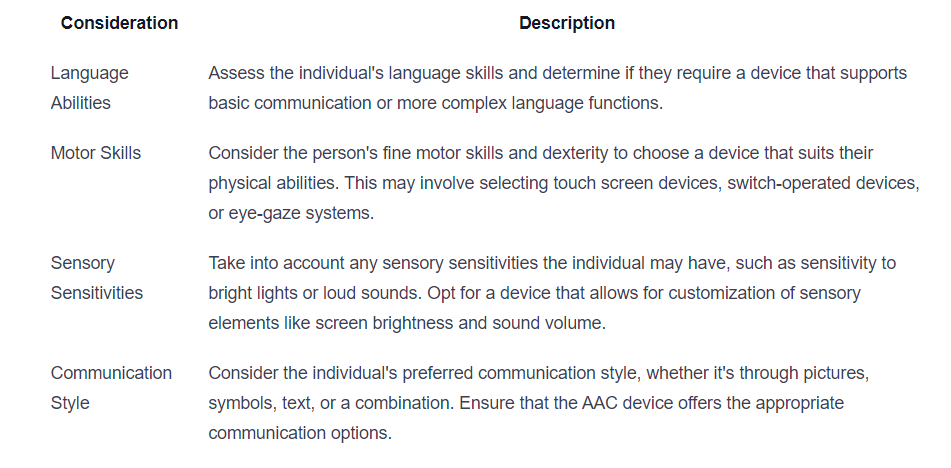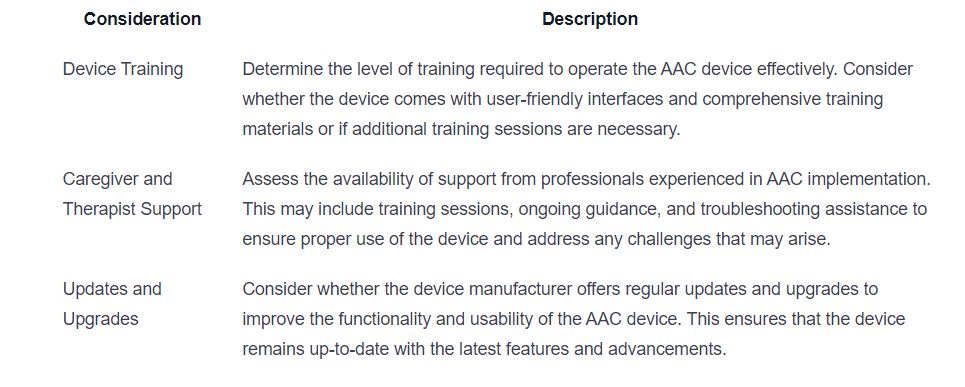What is an AAC Device for Autism?
Discover the power of AAC devices for autism. Bridge the communication gap and empower individuals with personalized tools!

Understanding AAC Devices for Autism
When it comes to aiding communication for individuals with autism, AAC (Augmentative and Alternative Communication) devices play a crucial role. These devices are specifically designed to support and enhance communication skills for individuals who have difficulty with verbal speech. Let's delve into the definition of AAC devices and understand their importance for individuals with autism.

Definition of AAC Devices
AAC devices refer to a range of tools and technologies that assist individuals with autism in expressing their thoughts, needs, and desires. These devices serve as a supplement or alternative to verbal speech, enabling individuals with limited or no speech abilities to communicate effectively with others.
AAC devices can take various forms, including low-tech options such as picture boards and communication books, as well as high-tech options such as tablet-based applications and speech-generating devices. These devices utilize symbols, pictures, text, or speech output to facilitate communication.
Importance of AAC Devices for Individuals with Autism
For individuals with autism, AAC devices are essential tools that help bridge the communication gap. These devices provide a means of communication for those who struggle with spoken language, allowing them to express themselves, share their thoughts, and engage with others more effectively.
AAC devices offer several key benefits for individuals with autism. They provide a means of communication that is not reliant on verbal speech, thereby reducing frustration and promoting independence. Additionally, AAC devices can enhance social interactions, improve relationships, and foster a sense of autonomy and empowerment.
By utilizing AAC devices, individuals with autism can participate more actively in social settings, educational environments, and daily activities. These devices offer a way to overcome communication barriers and provide a voice to individuals who may otherwise struggle to express themselves.
In summary, AAC devices are instrumental in enabling individuals with autism to communicate effectively. These devices serve as powerful tools that enhance communication skills, promote social interactions, and empower individuals with autism to express themselves and engage with the world around them.
Types of AAC Devices
AAC devices, or Augmentative and Alternative Communication devices, play a crucial role in facilitating communication for individuals with autism. These devices can be broadly categorized into two types: unaided AAC devices and aided AAC devices.
Unaided AAC Devices
Unaided AAC devices do not require any external tools or equipment and rely solely on the individual's body to communicate. These devices utilize gestures, facial expressions, sign language, and body language to convey messages. Unaided AAC devices are primarily beneficial for individuals who have the ability to control their body movements effectively.
Examples of unaided AAC devices include:
- Sign Language: Sign language involves using hand gestures, facial expressions, and body movements to communicate. It enables individuals to express themselves using a visual language system.
- Gestures: Gestures involve using specific hand movements or body motions to represent words or phrases. This can include pointing, waving, or nodding to convey meaning.
Aided AAC Devices
Aided AAC devices, on the other hand, require the use of external tools or equipment to augment communication. These devices utilize technology and various symbols or visuals to facilitate communication. Aided AAC devices are particularly useful for individuals who face challenges in controlling their body movements or have limited motor skills.
Examples of aided AAC devices include:
- Picture Exchange Communication System (PECS): PECS involves using a system of pictures or symbols that individuals can exchange to communicate their needs, wants, or thoughts. This system allows individuals to construct sentences or phrases by selecting and presenting the appropriate pictures.
- Communication Apps: There are a variety of communication apps available for smartphones and tablets that offer a range of features to support communication. These apps often include customizable symbol libraries, text-to-speech functionality, and the ability to create personalized communication boards.
- Speech-Generating Devices (SGDs): SGDs are electronic devices that generate speech output based on the user's input. These devices can range from dedicated communication devices to tablet-based applications. SGDs often offer multiple communication methods, such as text, symbols, or pictures, to cater to the individual's communication needs.
Selecting the appropriate AAC device depends on the individual's communication abilities, preferences, and specific needs. It is important to work closely with speech-language pathologists and other professionals to determine the most suitable AAC device for each individual with autism. By providing effective communication support, AAC devices help bridge the communication gap and empower individuals with autism to express themselves and interact with others more effectively.
How AAC Devices Work
AAC devices, or Augmentative and Alternative Communication devices, play a vital role in facilitating communication for individuals with autism. These devices utilize various communication methods and offer customization and personalization options to meet the specific needs of each individual.
Communication Methods
AAC devices employ different communication methods to enable individuals with autism to express themselves effectively. These methods can be divided into two categories:
- Symbol-based Communication: Symbol-based AAC devices use visual symbols, such as pictures, icons, or words, to represent concepts, objects, or actions. These symbols are organized on a communication board or displayed on a screen, allowing individuals to select the appropriate symbols to convey their messages. Symbol-based communication can be further subdivided into two types:

2.Text-based Communication: Text-based AAC devices utilize written words or sentences to facilitate communication. These devices typically feature a keyboard
or a touch screen, allowing individuals to type or select pre-programmed phrases or sentences. Text-based communication offers flexibility and can be particularly beneficial for individuals who have developed literacy skills.
Customization and Personalization
AAC devices can be customized and personalized to suit the unique communication needs of individuals with autism. Customization options may include:
- Vocabulary Selection: AAC devices can be tailored to include vocabulary relevant to the individual's daily life, interests, and activities. This ensures that the device contains words and symbols that are meaningful and relevant to the user.
- Voice Output: AAC devices often offer a variety of voice options, allowing individuals to select a voice that aligns with their preferences. Some devices even allow users to record their own voice, adding a personal touch to their communication.
- Access Methods: AAC devices can be adapted to accommodate different access methods based on the individual's motor skills and abilities. These methods may include touch screens, switches, eye-tracking technology, or head pointers.
By providing customizable features, AAC devices enable individuals with autism to communicate in a way that is comfortable, effective, and aligned with their unique capabilities.
Understanding how AAC devices work, including the various communication methods they employ and the ability to customize and personalize them, is crucial for individuals with autism and those supporting them. These devices serve as powerful tools to bridge the communication gap and empower individuals to express themselves, connect with others, and participate more actively in their environments.
Benefits of AAC Devices for Autism
AAC devices play a crucial role in improving communication for individuals with autism. These devices offer numerous benefits that enhance communication skills, improve social interactions, and boost self-expression.
Enhancing Communication Skills
One of the key benefits of AAC devices for autism is the enhancement of communication skills. Many individuals with autism face challenges in verbal communication, making it difficult for them to express their thoughts, needs, and emotions. AAC devices provide a means to bridge this communication gap.
By using AAC devices, individuals with autism can communicate their thoughts and ideas using symbols, pictures, or text. These devices facilitate the development of language and communication skills, enabling individuals to express themselves effectively. AAC devices provide a visual representation of language, making it easier to understand and comprehend information.
Improving Social Interactions
AAC devices also contribute to improving social interactions for individuals with autism. Communication is a fundamental aspect of socialization, and difficulties in communication can hinder social interactions. AAC devices empower individuals with autism to actively participate in conversations, engage with others, and establish meaningful connections.
With the help of AAC devices, individuals with autism can initiate conversations, respond to others, and express their feelings and opinions. This leads to increased social interaction and a greater sense of connection with peers, family, and the community. AAC devices act as a tool to break down communication barriers and foster social inclusion.
Boosting Self-Expression
AAC devices provide individuals with autism the opportunity to express themselves more fully. These devices give a voice to individuals who may otherwise struggle to communicate effectively. By using AAC devices, individuals with autism can share their thoughts, preferences, and experiences with others.
AAC devices offer a range of options for self-expression, including text, symbols, or pictures. This versatility allows individuals to choose the mode of communication that best suits their needs and abilities. By having a means to express themselves, individuals with autism can build confidence, self-esteem, and a sense of autonomy.
The benefits of AAC devices for autism are undeniable. By enhancing communication skills, improving social interactions, and boosting self-expression, these devices empower individuals with autism to overcome communication barriers and participate more fully in society. It is important to consider the individual needs and preferences when choosing an AAC device, as well as provide the necessary training and support to ensure successful integration and utilization of these devices.
Considerations When Choosing an AAC Device
Individual Needs and Preferences
When selecting an AAC (Augmentative and Alternative Communication) device for individuals with autism, it's crucial to consider their individual needs and preferences. Each person with autism has unique communication abilities and challenges, so finding the right device that aligns with their specific requirements is essential.

Training and Support
It's essential to consider the training and support that comes with the AAC device. Adequate training for both the individual with autism and their caregivers or therapists is crucial for successful implementation and utilization of the device.

Integration with Other Therapies
When choosing an AAC device for individuals with autism, it's important to consider how the device integrates with other therapies and interventions. AAC devices can complement various therapeutic approaches and enhance overall communication development.

By carefully considering individual needs and preferences, training and support options, and integration with other therapies, one can select an AAC device that best meets the communication requirements of individuals with autism. This thoughtful selection process enhances the effectiveness and success of AAC interventions, empowering individuals with autism to communicate and engage with the world around them.
Overcoming Communication Barriers
Individuals with autism often face significant communication challenges, making it difficult for them to express their thoughts, needs, and emotions. AAC devices play a crucial role in bridging the communication gap and helping individuals with autism overcome these barriers. Let's explore three key aspects of how AAC devices contribute to overcoming communication barriers: encouraging acceptance and understanding, promoting inclusivity, and empowering individuals with autism.
Encouraging Acceptance and Understanding
AAC devices not only facilitate communication but also promote acceptance and understanding among individuals with autism and those around them. By using AAC devices, individuals with autism can effectively convey their thoughts and feelings, enabling others to better understand their perspectives. This increased understanding fosters empathy, patience, and acceptance, creating a more inclusive environment for individuals with autism.
Promoting Inclusivity
Inclusive communication is a fundamental aspect of AAC devices for individuals with autism. These devices provide a means for individuals with autism to participate in conversations, interact with others, and engage in social activities. By using AAC devices, individuals with autism can actively contribute to discussions, share their ideas, and be part of the communication process. This promotes inclusivity and ensures that everyone's voice is heard, regardless of their communication abilities.
Empowering Individuals with Autism
AAC devices empower individuals with autism by giving them a voice and enabling them to express themselves confidently. These devices provide a platform for individuals with autism to communicate their thoughts, needs, and desires independently. By using AAC devices, individuals with autism can actively engage in social interactions, make choices, and assert their preferences. This empowerment enhances their self-esteem, autonomy, and overall quality of life.
By encouraging acceptance and understanding, promoting inclusivity, and empowering individuals with autism, AAC devices play a vital role in overcoming communication barriers. These devices provide individuals with autism the tools they need to communicate effectively, connect with others, and actively participate in various aspects of life. Through the use of AAC devices, individuals with autism can break free from the constraints of limited verbal communication and achieve greater communication success.
Sources
https://www.autism.org.uk/advice-and-guidance/professional-practice/aug-alt-comm
https://www.hopebridge.com/blog/what-is-an-aac-device-for-communication/
Similar articles
We’re here to help you

Our team is here to assist you in this process. Contact us for any assistance.
it’s easy to apply
We Accept Most Insurances
Our in-network insurance partnerships make ABA therapy more accessible to families throughout our service areas.







Our Insurance Process
We'll request your insurance details to help us verify your plan's coverage for ABA therapy. Once we've received this information, we'll walk you through your benefits, including copayments, deductibles and out-of-pocket maximums, so you know what to expect in advance.
Our team will then handle the preauthorization and all the necessary paperwork.
.svg)





















.jpeg)


































.jpeg)




.jpeg)







.jpeg)











.jpeg)
















